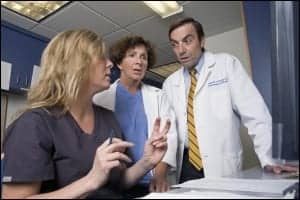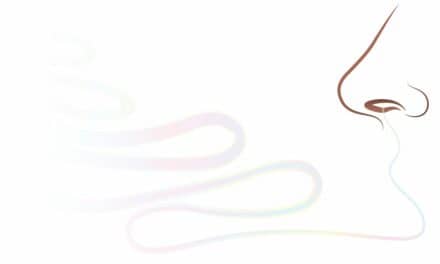
Patrick J. Strollo, Jr, MD, FCCP, FAASM (right), discusses approaches to patient care with Rebecca Timms, CRT, RPSGT, pulmonary sleep technologist III (left), and Nancy B. Kern, CRT, RPSGT, patient care coordinator, UPMC Sleep Medicine Center.
Patrick J. Strollo, Jr, MD, FCCP, FAASM, associate professor in the University of Pittsburgh’s Division of Pulmonary, Allergy, and Critical Care, will spend the next year guiding the field as president of the American Academy of Sleep Medicine. In an interview with Sleep Review, Strollo gives his take on the development of the Obstructive Sleep Apnea (OSA) Physician Performance Measurement Set and how it will serve the sleep community’s move toward pay for performance programs. He also shares his thoughts on the need for more sleep physicians in certain specialties to go into academic research to keep the field moving forward, as well as the new match program for fellows and licensure process for sleep technologists.
Sleep Review: From your perspective as cochair of the committee that developed the OSA Physician Performance Measurement Set, how do you envision these measurement sets ultimately being embraced and used by the sleep medicine community for pay for performance programs?
Strollo: One of the challenges with pay for reporting, and also pay for performance—which is where the field needs to go—is that you have to make sure that any measurement sets that you develop are actually applicable to specialists and subspecialists. A lot of the original measurement sets developed and endorsed by the National Quality Forum are really directed more to primary care. However, the number of patients who are involved in subspecialist and specialist care has actually increased from 1980 to 2004. So any measurement sets that we develop have to actually resonate with an individual’s practice. That’s why we felt that the first measurement set in sleep medicine should be in OSA.
The reason to develop an OSA measurement set is to be able to reach out to specialty practices in sleep medicine—like pulmonologists who have a large investment in sleep medicine and can be sleep specialists as well as certified in pulmonary medicine. It’s a measurement that pulmonary sleep specialists could use, or people who practice solely sleep medicine could use, to measure whether they’re actually aligning their management in an appropriate fashion.
Any sort of performance measure should really be an iterative process—you make the measurement, you look at the results, you make a change in your practice so that you can improve the practice. That improvement may not necessarily be on an individual physician level; it may be more on a system level in terms of a group practice, or maybe even a practice that incorporates primary care doctors and specialists. The idea is to really attain a signal, react to that, and make a change in your practice so you improve patient care. In order to do that, the electronic medical record is clearly an advantage. What a lot of the pay for performance and pay for reporting initiatives have relied on to date has been more claims measures that relate to diagnostic codes and then claims for visits, but that doesn’t give you the granularity of data that an electronic medical record can give you. The barrier that we have currently is that probably only 15% to 20% of the physician population is on electronic records. But that’s clearly where the future of medicine is going.
SR: One of the initiatives that you mentioned in your acceptance speech as AASM president was the development of patient registries specific to sleep. How will patient registries serve as a useful tool for sleep medicine professionals as patient care models shift? What role can patient registries play in maintenance of certification?

Patrick J. Strollo, Jr, MD, FCCP, FAASM, explains the sleep study process to Shelly L. Worthy. He supports initiatives such as patient registries in order to support ongoing performance improvement for sleep medicine professionals.
Strollo: We think that a board-certified specialist in sleep medicine provides better care and usually results in better outcomes with patients—but really the evidence base is somewhat limited. The challenge for the field is to make sure we identify that there truly is value added for specialist care in sleep medicine, much like there is value added for specialist care in cardiology. You have to be armed with the data and then be able to react to the data to hopefully positively influence overall patient care.
One of the initiatives that I have for this upcoming year for the American Academy of Sleep Medicine and we’re in the process of developing is a clinical registry for accredited centers so that physicians who practice sleep medicine can actually enter more robust data and work on performance improvement measures to change their practice and improve care. If you don’t have data, you can’t possibly make any reasonable changes. This is a very important initiative that will hopefully serve a few goals. Number one, it will allow physicians who practice sleep medicine to be able to participate in a performance improvement program that’s relevant to their practice for the purpose of recertification by the American Board of Internal Medicine for their sleep certificate. Number two, it will allow the sleep community to understand what the value added is of whatever type of change we make in practice.
SR: During the AASM Sleep Medicine Fellowship Directors Forum at the SLEEP conference, directors discussed the 2011 inclusion of sleep medicine in the National Resident Matching Program. What effect do you think the implementation of the matching program will have on the fellowship process for both applicants and participating organizations? How will this benefit the fellowship programs?
Strollo: This is a reflection of the increasing maturity of sleep training programs. Most ACGME [Accreditation Council for Graduate Medical Education] training programs go through a match, and what that allows the candidates and also the programs to do is to better balance the training experience. Without a match, many times potential fellows who are not well plugged into the sleep community may not know all the opportunities that are available to them and may not be competitive for a top tier program even though they’re top performers. Outside of the match, if you don’t already have a match, programs frequently will identify trainees and have them commit very early on so they’re not going to interview elsewhere. So a training program could conceivably have an unfair advantage in taking top tier candidates before they get the opportunity to have additional interviews and get to see other programs. On the flip side, if you don’t have a match, there may be training programs that are quite good but for whatever reason don’t get to see trainees who would be a good fit for their programs.
I know there was a fairly heated discussion regarding the match issue at the fellowship directors meeting, but I think this really is the right way to go. It’s the standard in most ACGME training programs. It evens the field and makes sure that both the trainees and the training programs have equal access.
SR: Another issue raised during the fellowship directors forum was the need for more cardiopulmonary specialists coming into sleep medicine and continuing on into academic research. Is there a need for more doctors in specific areas of sleep medicine research like cardiopulmonary or neurology? What efforts can be made to draw more specialists from these areas into sleep medicine?
Strollo: This is a hot button issue. One of the areas of concern in academic sleep medicine is that there seems to be a decreased number of specialists in pulmonary disease who are electing to pursue further training in sleep medicine. The pulmonary specialists do 3 years of internal medicine; they do usually 2, and frequently 3, years of pulmonary critical care fellowship; and then there’s the expectation to do an additional year, which is a postgraduate year seven of training. That’s one problem. It’s a long training time, but in academic medicine, people are used to that so that’s not [the main] problem.
The more concerning thing is the siloing of the sleep experience in pulmonary programs for trainees. The proposal that is currently out there is not to decrease the amount of training time but to better integrate the training experience in pulmonary training programs that wish to participate. Ilene M. Rosen [MD, MSCE, assistant professor in the Division of Sleep Medicine at the University of Pennsylvania] is going to survey the current training programs and get a better sense from the current program directors of what their needs were. I proposed this because this is a concern that was raised by sleep specialists from the American Thoracic Society and the American College of Chest Physicians who are certified in sleep medicine. They feel they are not seeing the best trainees who would be candidates to go into research careers in pulmonary sleep medicine. But how big of an issue this is for current training programs, I don’t know.
I think there’s certainly a need to make sure we identify and we support individuals who want to do research in sleep medicine be it pulmonary or neuroscience or movement disorders, and how we can attract the best people to go into research careers is very important because generating new knowledge through research is really the lifeline of any specialty. You have to constantly be asking new questions, developing new tools, techniques, and treatments to help patients.
SR: Are there other specialties where there are similar concerns about people going into academic research?
Strollo: Yes. In some of the preliminary discussions we’ve had, pediatric sleep specialists—many come from pediatric pulmonary programs—have somewhat of a similar issue. Plus the way the current board is set up and the exam is administered, someone who is a pediatric sleep specialist has to take an exam that is primarily focused on adult sleep medicine. There is some discussion to try to change the requirements for pediatricians who take care of sleep disorders to have their training really be more focused on pediatric patients.
One of the rich aspects in our field is the fact that it is horizontally integrated and not vertically integrated. And one of the components that sometimes makes changing policy somewhat difficult is that our field is comprised of a variety of different specialists who focus on sleep as the main area where they direct care. And that sometimes is a little bit of a challenge because everyone comes from a different background.
I think part of this whole process is we’re a relatively young field, we’re in an evolution, but there are a lot of very positive things that have occurred. I’m very hopeful that we’re going to continue to evolve with the ultimate goal of providing great patient care.
SR: During the AASM Sleep Technologists Issues Forum, there was discussion about the status of licensure legislation for sleep technologists. What is the current status of the movement toward licensure?
Strollo: Conceptually, it’s the right thing to do to have your medical professionals licensed. I think the tricky thing is to do this in a manner that is fiscally possible. That’s kind of where the field is right now. The legislation is in place in many states to require licensure for sleep technologists. We just have to be mindful of the cost. My concern is not so much the initial license but how do we ensure that people are continuing to be involved in education in that particular area to provide the best care for patients.
In some respects, this is a good problem to have. It really reflects that the profession is maturing, not only from the physician’s perspective, but also for the technicians who are vital in providing care for our patients.
Alison Werner is associate editor for Sleep Review. She can be reached at [email protected].




